Huawei TaiShan 200 2280 Internal Server Overview
For this piece, we are going to show more angles and photos than we normally do of some specific parts of the server’s internals. We realize this is an important industry platform, but it is also one that few of our readers will have seen.
Huawei TaiShan 200 2.5″ NVMe SSD and SATA/SAS Backplane
Taking a look at the front of the chassis, we can see the storage backplane, a large channel for cables, then the fan partition.
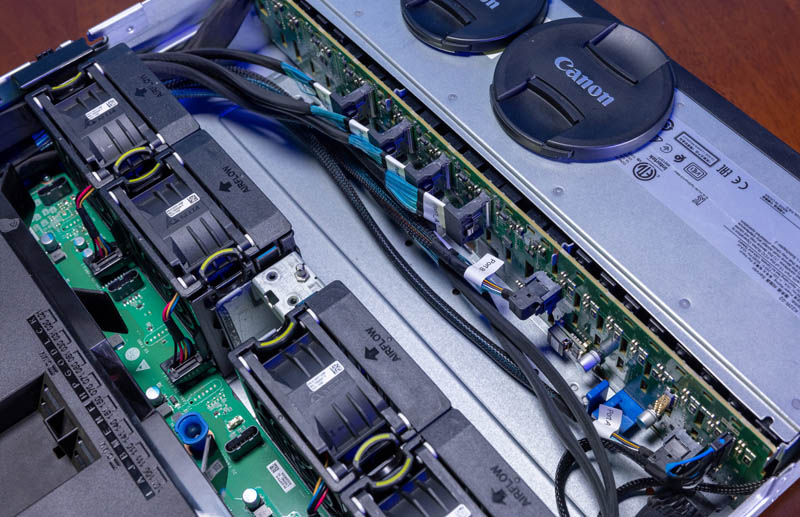
The storage backplane supports up to eight PCIe Gen4 x4 NVMe SSDs. It also has provisions for the other sixteen slots being SATA/ SAS.
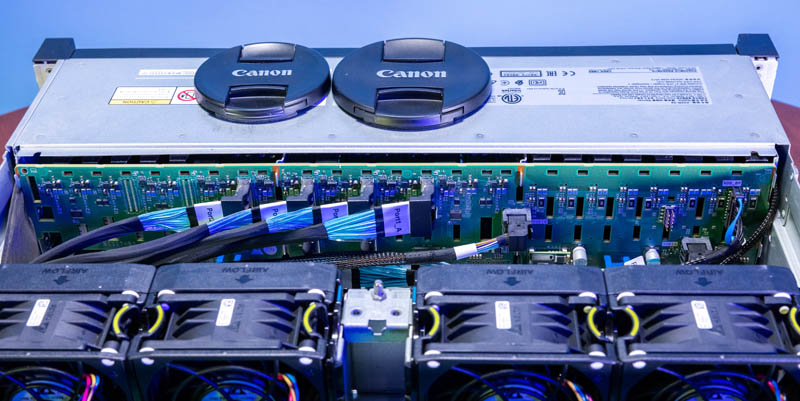
For those wondering from photos, the backplane is not bent wildly. Instead, the sheet metal above the backplane has a curve to it.
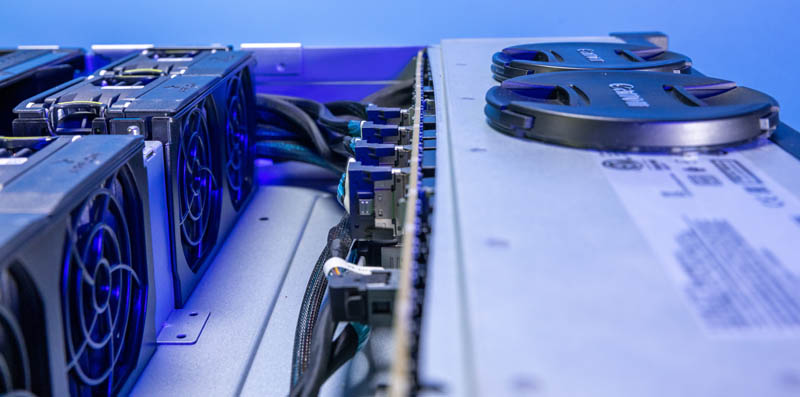
Something that is different here is that we see a lot of the industry move to backplanes that are segmented into thirds on 2U 24-bay designs. That allows flexibility in configuration and reduces the failure domain if a backplane fails. 8-drive backplanes for 2.5″ are also easier to service. Still, it is just interesting to see how this server is built.
Huawei TaiShan 200 Cooling
The middle of the chassis, behind the storage backplane is designed for cooling. There are four large fans and then an airflow guide. Here we can see that setup, and also a small but nice feature with the DIMM slots labeled on the airflow guide along with which CPU is which. This is a small feature but a nice one to have whenever a DIMM fails and needs to be serviced.
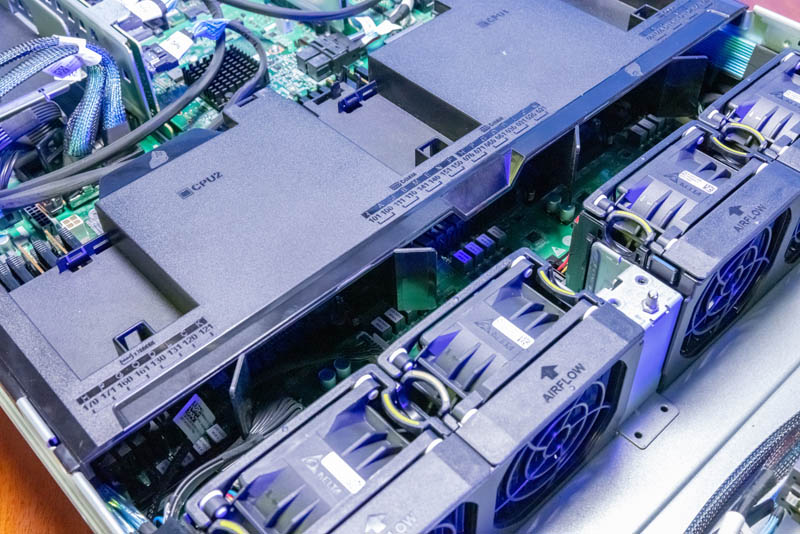
The fans use six-pin custom connectors, but the fans only have five wires so not all six pins are being used. The fans are non-redundant and do not have counter-rotating designs. Still, it appears as though there are several unused fan connectors on the motherboard. There are also unpopulated pads labeled for 1U servers. As a result, we think there are 1U versions of this motherboard with those fan headers populated and perhaps even other fan configurations that we do not have.
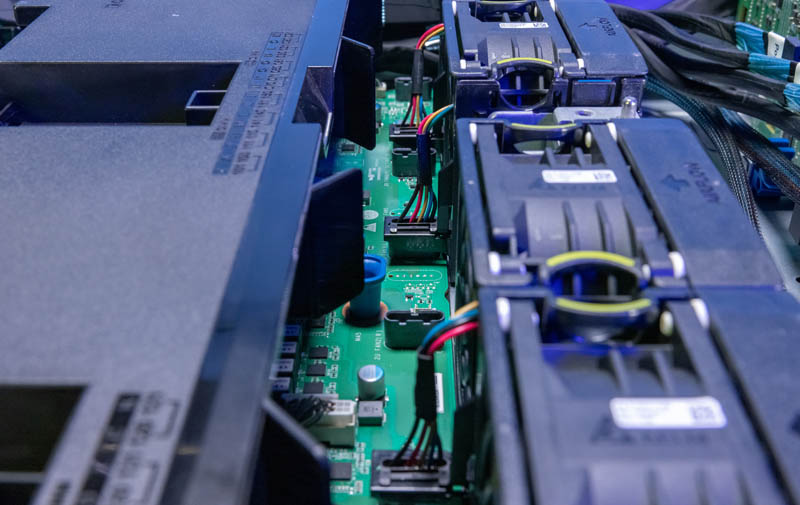
Perhaps the most interesting part here is the giant gap. Between the fans and the airflow guide over the CPUs, there is a very large gap when most servers start the airflow guide directly at the exhaust of the fans to reduce airflow turbulence. Huawei does not do this. For those who are wondering if the airflow guide was in the wrong place, there are notches it fits into on the chassis edge to keep it situated. This is very different from most server designs we see from other vendors.
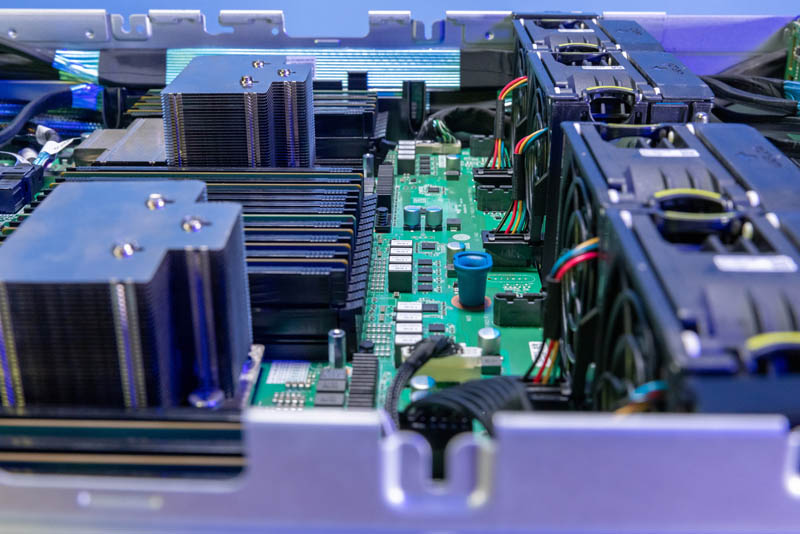
The fans themselves actually fit easily into the custom connectors. Given the design, we did not know how that hot-swap process would work. It was certainly an upside surprise.
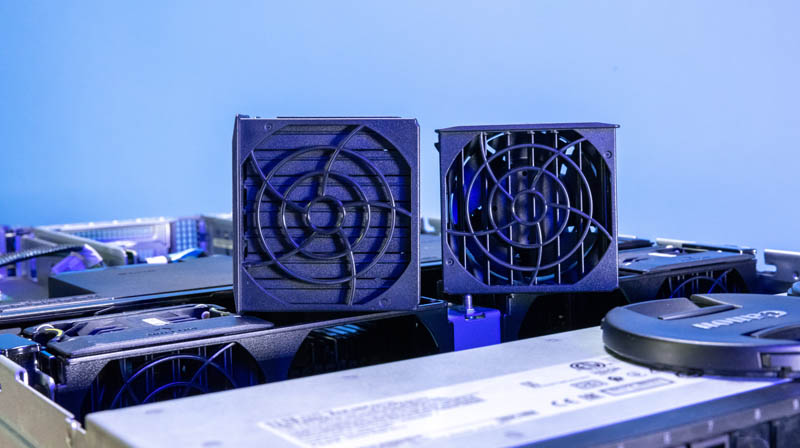
Something that was a bit different with the fans is that they have slats. These slats allow air to pass during normal operation. If a fan fails, these slats can close, thereby not allowing airflow leakage through the stopped fan.
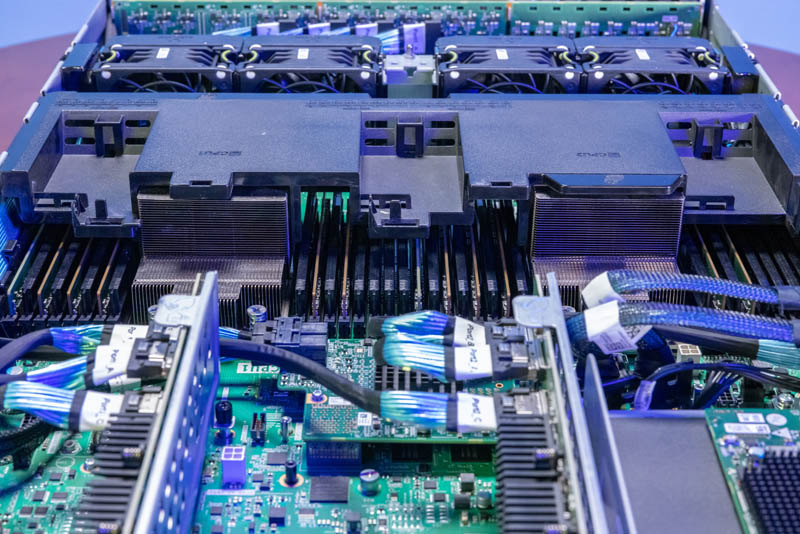
The top of the airflow guide also has spaces for BBU mounting for RAID controllers. We did not have these batteries, but this is a common spot to place them in servers.
Huawei TaiShan 200 Kunpeng 920 CPUs and DIMMs
The CPU area looks very modern. We get two CPUs with large heatsinks and 16x DIMMs for each CPU. That means 8-channel memory and a total of 32 DIMMS. This is similar to the Ampere Altra (Max), AMD EPYC, and Intel Ice Lake Xeons of the DDR4 era.
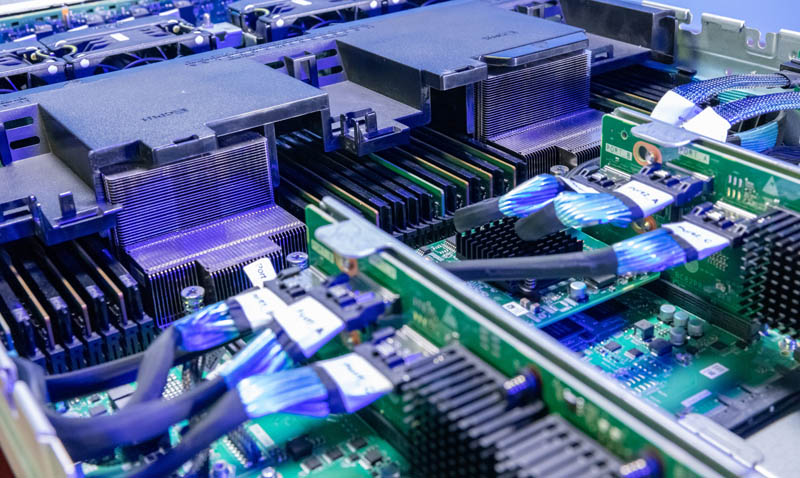
Here is a look at the area with the airflow guide removed.
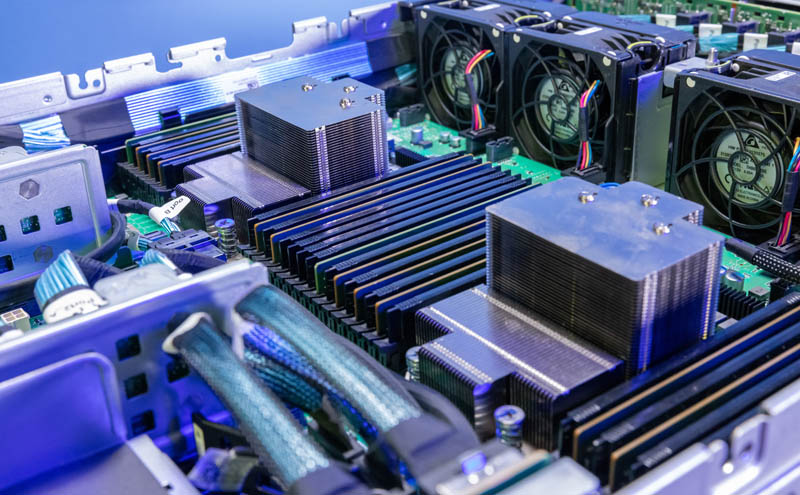
Here it another view. One will notice our server came with 6 DDR4 DIMMs per CPU. The memory is DDR4 ECC and supports RDIMMs. We are using 8x 32GB per CPU for performance testing, but there are still some quirks to iron out. In our recent Solidigm D7-P5520 7.68TB PCIe Gen4 NVMe SSD Review on x86 Arm and Power9 it took some time just to get something as simple as that NVMe SSD working reasonably well on this system.
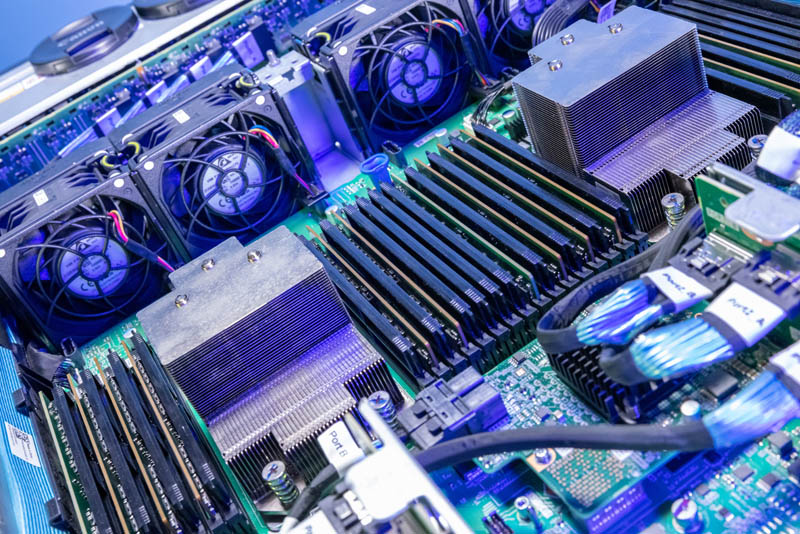
The CPUs themselves are Huawei, HiSilicon Kunpeng 920 models. They are 48 core 2.6GHz CPUs. Kunpeng 920 models scaled to 64 cores, but this is what we can get. As we get the system sorted, we will have more formal performance figures, but our 48 core models are roughly equivalent to Cascade Lake 24 core Xeon models in integer workloads. There is more memory bandwidth available and PCIe in this platform.
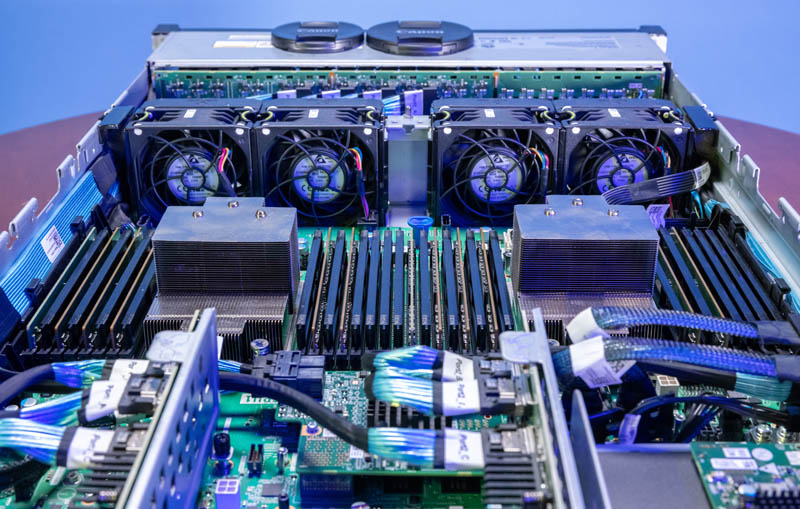
Perhaps one of the most interesting connectors we saw was this one. The “CPU1 Hydra” connector.
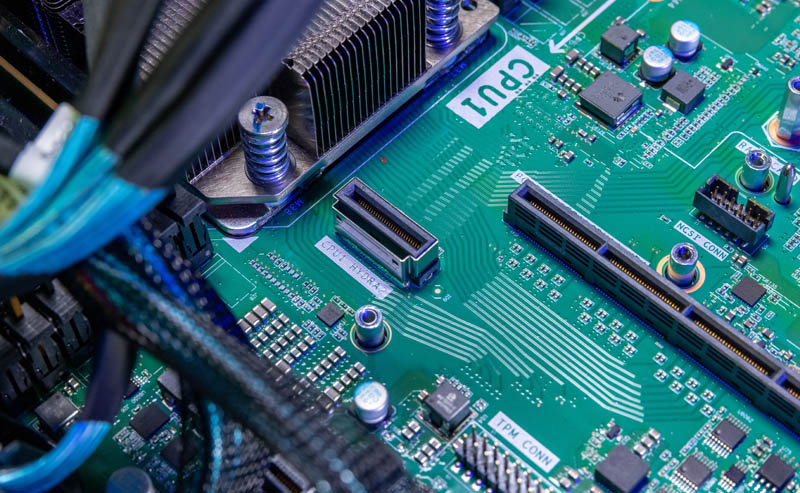
Here is the CPU2 Hydra connector:
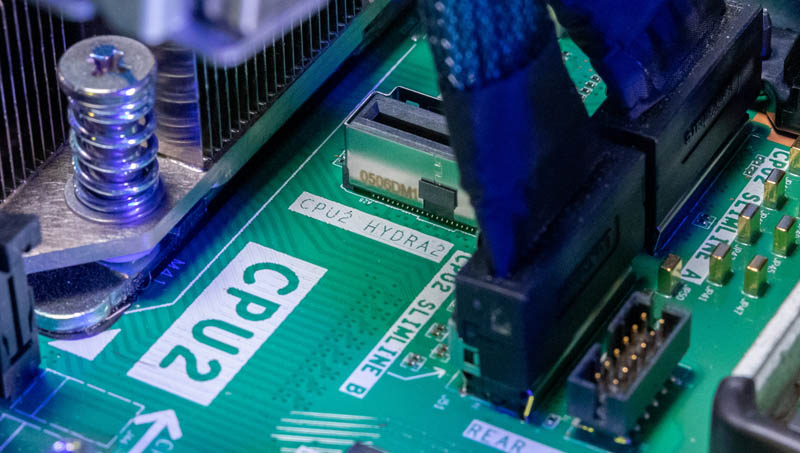
Hydra is the name given to Huawei’s CPU to CPU interconnect and seems to be roughly analogous to AMD EPYC’s Infinity Fabric and the Intel Xeon UPI. We typically do not see UPI cables. We see the AMD EPYC IF cables from time to time as they can be repurposed to PCIe lanes, as we saw in our Dell EMC PowerEdge R7525 review. We will show Hydra a bit more in the block diagram section of this article.
Next, we are going to take a look at the motherboard in a bit more detail.




Interesting read. Very strange that the BMC chip is undocumented. Furthermore in the blockdiagram they talk about a different model chip.
I did spot a small error in the writing:
Lenovo servers are probably a step above Huawei, then this Huawei server.
You may not have gotten far enough along in this test for the question be applicable, but does STH routinely monitor network-connected devices for “unexpected” traffic?
@Joeri – I made that a bit clearer. I agree it was chewy wording.
@Bob Niland – we are not tooled to check like a security research firm is. I would expect what you are looking for is rather sophisticated and we do not have a team that can sift through live traffic for days.
Patrick, please, stop filming hanging hardware.
There is no details visible and earlier way of showing thing was a lot better.
Please return to blue doors.
Actually it’s 25-bay backplane.
That’s a catchy headline!
But I fail to find any substance behind it: why exactly is it both forbidden and banned? And from where and under which penalty?
And just in case it’s explained in the video: I never watch those. I come to STH precisely because it can be read.
@abufrejoval
Huawei is sanctioned in the US and you can’t import it legally.
Wow these comments are off the charts. Such an out of control crowd of nerds going squirrelly over circuitry from abroad. I am lost for words. How could you keep your comments section open even after addmjtting you expected such an obvious culling of naysayers … …. …
;)
The worst thing is the cluelessness of the outright IP theft from them. HP had lots of patents on Moonshot and now they co-developed a machine with Fujitsu that looks at lot like the Huawei here. Aren’t y’all tired of the Chinese theft of intellectual property?
I fully expected more Engrish text in this server, but there is no American Megatrands or similar text to be found.
The lscpu result shows 4 NUMA nodes. This is a 2P server, so is that BIOS configuration option or is it just the way the CPU is designed?
What’s a “retimer” in this context? Its a legitimate chip for re-timing signals, but in this usage might be typo ?
@chris s I just wanna know what they’re not showing
@criggie that’s what they’re saying. you’ll see servers like dell’s and others use pcie retimers when they’re taking signals from pcie slots and then converting them to cables. there’s signal loss when you go cpu mobo->riser so then when you go cpu mobo->riser->long cable->front->nvme back plane->nvme SSD you need to boost the signal. a lot of servers use pcie retimers because of this. there’s also loss not just because of distance but also they’ve got loss from each connector
“HUR DUR Evil chinese communist theft of intellectual property !
-Written from my iPhone”
LOL
Sorry Yankees, we Chinese have surpassed you. Talk all you want about theft. You stole earlier tech from us: guns, paper, gunpowder, silk, steel, kite , etc
If it is banned how was it imported?
@ dalong Ning
We stole from you lol… Chinese business and government would steal and clone your grandma if they had a chance and could make profit!
No you have not surpassed us… our cpus, phones, cars and etc are alot better then the crap your country makes.
@Jay the funny thing is there has been 100s of cases where you “Chinese” work for many tech companies and have been caught stealing and sharing what “We” make, if your tech is so superior then please answer this, what do you guys need with anything we have created?
Only reason it’s banned in USA is that Huawei CPUs are secure and do not have CIA bookmarks, like Intel and AMD. Not even taking about backdoor controller Microsoft Pluton.
Loving these comments. There is a reason why the world needs Chinese chips. Just hope for a peaceful future. May be biased because I’m engaged to a wonderful Chinese person.
Huawei makes everything better than any company in the US can make.
I love seeing folks trying different solutions. Sometimes it works and tech gets better. I wonder if Huawei’s choices will have an impact.